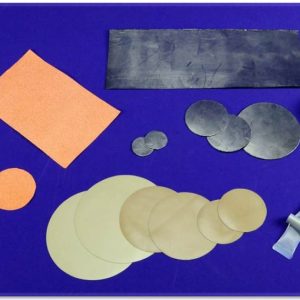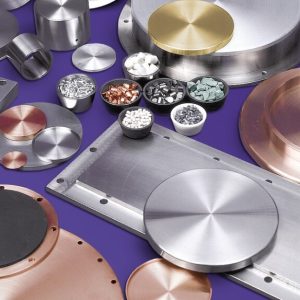Description
PVD or Physical Vapor Deposition Materials comprise a range of materials that can be used to create thin film coatings. Angstrom Sciences offers a comprehensive selection of high-purity vacuum deposition materials including shown above.
There are three factors that influence the quality and functionality of a film deposited by Physical Vapor Deposition (PVD): the quality and performance of the deposition source, the properties and structure of the deposition materials, and the intrinsic performance and layout of the deposition system and its’ associated peripherals. Angsstrom Sciences has the abilities and know how to control two of these three main factors.
From sputtering targets of any size to materials used for thermal / e-beam evaporation, Angstrom Sciences has the ability to suggest and direct the most suitable materials for any application. Not all materials are equivalent in these processes as the chemical composition of the source material is only the starting point of a robust, application-specific process. Impurity levels, grain size, crystallographic structure/texture are but a few of the considerations that go into uniquely tailoring the structure of a suitable deposition structure. We draw from variety of specialized processing techniques such as Hot Pressing, Cold Pressing, Hot Isostatic Pressing (HIP), Cold Isostatic Pressing (CIP), Vacuum Induction Melting (VIM) and Vacuum Arc Casting to produce homogenous, fine-grained, high-density materials that conform to the strictest application standards. All of our PVD materials are provided with a NIST traceable composition and impurity analysis. Click here for a list of materials we have delivered in the past; recognizing that this list only scratches the surface of the compositions that we can offer.At Angstrom Sciences no order is too small or too big. There are no minimum lot-size requirements for custom compositions and our extraordinary focus on customer service is the envy of the industry. We routinely provide backing plates (copper, molybdenum, copper-chromium) for planar, circular and cylindrical sputtering targets, conductive pastes and thermal transfer foil for sputter target cooling, and also offer bonding services as part of our comprehensive range of services to the PVD community.
For more information about PVD Materials or how Angstrom Sciences can help your business call 412-469-8466 or contact us online.
Additional information
| Material | Aluminium, Aluminum Copper, Aluminum Copper Tungsten, Aluminum Nitride, Aluminum Oxide, Aluminum Silicon, Antimony, Barium, Barium Ferrite, Barium Fluoride, Barium Oxide, Barium Strontium Titanate, Barium Titanate, Beryllium, Bismuth, Bismuth Lanthanum Titanium, Bismuth Strontium Calcium, Bismuth Strontium Titanate, Bismuth Titanium Oxide, Bismuth Trioxide, Boron, Boron Carbide, Boron Nitride, Cadmium Fluoride, Cadmium Oxide, Cadmium Selenide, Cadmium Sulfide, Cadmium Telluride, Calcium Fluoride, Calcium Oxide, Calcium Silicate, Calcium Titanate, Carbon (Graphite), Carbon Steel, Cerium, Cerium Oxide, Chromium (Cr), Chromium Boride, Chromium Oxide, Chromium Silicide, Cobalt, Cobalt Chromium, Cobalt Oxide, Cobalt Silicide, Cobalt Zirconium, Copper, Copper Oxide, Copper Sulfide, Dysprosium, Erbium, Europium, Gadolinium, Gallium, Gallium Arsenide, Gallium Oxide, Germanium, Germanium Nitride, Germanium Oxide, Gold, Gold Germanium, Gold Palladium, Gold Tin, Gold Zinc, Hafnium, Hafnium Carbide, Hafnium Nitride, Hafnium Oxide, Holmium, Inconel, Indium, Indium Oxide, Indium Tin Oxide, Iridium, Iron, Iron Oxide, Lanthanum, Lanthanum Aluminate, Lanthanum Boride, Lanthanum Manganese Oxide, Lanthanum Oxide, Lanthanum Strontium Cobalt Oxide, Lead, Lead Oxide, Lead Titanate, Lead Zirconium Titanate Oxide, Lithium, Lithium Carbonate, Lithium Cobalt Oxide, Lithium Niobate, Lithium Phosphate, Lithium Tantalate, Magnesium, Magnesium Fluoride, Magnesium Monoxide, Magnesium Oxide, Manganese, Molybdenum, Molybdenum Disulfide, Molybdenum Oxide, Molybdenum Selenide, Molybdenum Silicide, Molybdenum Sulfide, Neodymium, Neodymium Gallium Oxide, Neodymium Iron Boride, Nickel, Nickel Chromium, Nickel Cobalt, Nickel Oxide, Nickel Silicide, Nickel Vanadium, Niobium, Niobium Oxide, Palladium, Platinum, Praseodymium, Pryolytic Boron Nitride, Rhenium, Rhodium, Ruthenium, Samarium, Samarium Cobalt, Scandium, Scandium Oxide, Selenium, Silicon, Silicon Carbide, Silicon Dioxide, Silicon Monoxide, Silicon Nitride, Silver, Silver Oxide, Strontium Bismuth Niobium Oxide, Strontium Bismuth Tantalum Niobium, Strontium Oxide, Strontium Titanate, Strontium-doped Lanthanum, Tantalum, Tantalum Carbide, Tantalum Nitride, Tantalum Oxide, Tantalum Silicide, Tantalum Sulfide, Tellurium, Terbium, Terbium Iron, Thallium, Thallium Oxide, Thorium Fluoride, Thorium Oxide, Tin, Tin Oxide, Titanium, Titanium Boride, Titanium Carbide, Titanium Nitride, Titanium Oxide, Titanium Silicide, Titanium Sulfide, Tungsten, Tungsten Silicide, Tungsten Titanium, Vanadium, Vanadium Pent Oxide, Yttrium, Yttrium Barium Copper Oxide, Yttrium Oxide, Zinc, Zinc Oxide, Zinc Selenide, Zinc Sulfide, Zirconium, Zirconium Nitride, Zirconium Oxide, Zirconium Oxide Yttrium Oxide, Zirconium Silicate |
|---|





